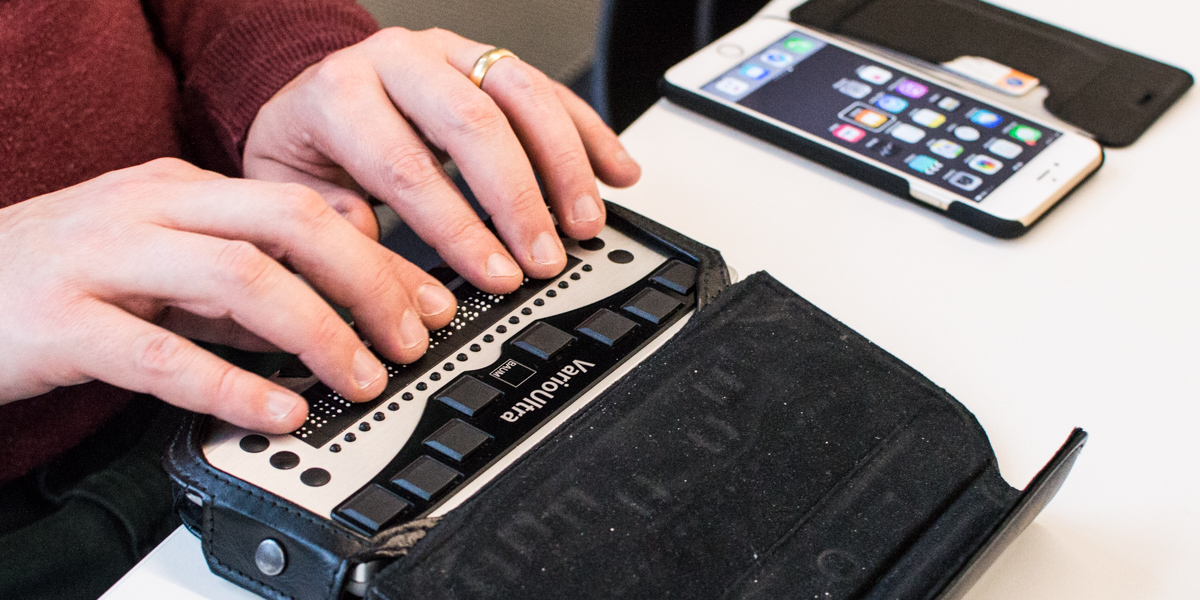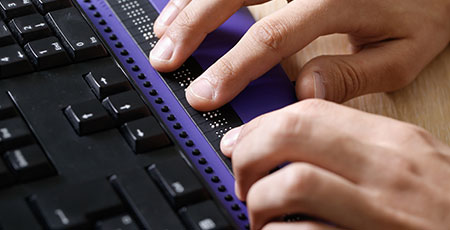Assistive Technology for the Blind: Innovations to Transform Lives
Assistive Technology for the Blind: Innovations to Transform Lives
Blog Article
Discover Ingenious Tools Developed for the Aesthetically Damaged
The growth of ingenious devices for the visually damaged stands for a significant innovation in availability and self-reliance. Technologies such as clever glasses with AI capabilities and mobile applications developed to offer acoustic summaries are improving day-to-day experiences for individuals. Furthermore, wearable devices that use haptic comments improve environmental awareness, while contemporary Braille technologies offer new methods to engage with text. As these tools proceed to advance, their effect on the lives of those with aesthetic disabilities elevates essential concerns concerning the future of inclusivity and autonomy in different facets of life. What exists in advance in this technological landscape?
Smart Glasses for Navigating

Smart glasses designed for navigation are transforming the way aesthetically damaged people connect with their atmosphere. These advanced devices make use of a combination of electronic camera modern technology, fabricated knowledge, and acoustic responses to offer real-time info concerning surroundings. By utilizing barrier detection systems, smart glasses can signal customers to potential threats, making it possible for safer movement in both unknown and familiar setups.
The integration of GPS innovation better boosts navigation capacities, enabling users to obtain acoustic directions as they move. This hands-free strategy not only fosters self-reliance but additionally encourages visually damaged individuals to navigate metropolitan landscapes with increased self-confidence. Additionally, many wise glasses are furnished with attributes that recognize sites and road indications, giving contextual information that improves the individual experience.
In addition, the advancement of these devices is continually progressing, with companies functioning to enhance the precision of object recognition and increase the array of navigational features. As wise glasses become much more obtainable and inexpensive, they hold the prospective to substantially change life for aesthetically damaged users. Eventually, these ingenious devices stand for a vital action toward inclusivity, offering improved flexibility and a higher sense of autonomy for people navigating the world around them.

Mobile Apps for Daily Living
How can mobile applications enhance the lives of aesthetically impaired people? Mobile applications are changing the means visually impaired users navigate their environments, handle day-to-day jobs, and accessibility details. These applications supply crucial support with various performances, cultivating freedom and enhancing high quality of life.
A number of innovative mobile applications are made specifically for daily living. Applications like Be My Eyes attach visually impaired individuals with sighted volunteers using video phone calls, enabling them to obtain real-time help with jobs such as reading tags or navigating strange rooms. Seeing AI, developed by Microsoft, makes use of man-made knowledge to define surroundings, read message, and determine objects, efficiently changing a smart device right into an effective tool for everyday help.
Additionally, navigating apps customized for the visually damaged, such as Aira and BlindSquare, provide audio-based instructions and environmental info, enabling users to traverse their environments safely and confidently. Beyond navigation and instant assistance, mobile apps additionally support organization and job monitoring, with functions that assist users establish reminders, develop to-do checklists, and track appointments. In recap, mobile applications function as important resources, encouraging aesthetically impaired people to lead even more independent and satisfying lives.
Wearable Technologies for Help
Empowerment through technology is progressively obvious in the world of wearable devices created to help aesthetically damaged people. These ingenious devices incorporate perfectly into life, enhancing navigation and giving essential responses to individuals. Smart glasses geared up with cameras can recognize faces and review message out loud, permitting customers to communicate even more confidently in social and professional settings.
Another significant advancement is using haptic responses systems in wearable tools. These systems make use of resonances or various other responsive signals to communicate information about the individual's environment, such as obstacles or changes in surface, enhancing flexibility and safety. Wearable innovations additionally include wristbands that link to smartphones, notifying customers to notifications through subtle index vibrations, therefore improving connectivity without reliance on visual signs.
As these modern technologies continue to advance, they are not only improving freedom for visually damaged individuals however additionally cultivating a better feeling of inclusion in society. By connecting the gap in between challenges encountered in day-to-day living and the potential for autonomy, wearable innovations act as critical devices in the mission for equality and empowerment for those with visual disabilities.
Sound Summary Devices
Audio summary devices play a crucial duty in boosting availability for visually damaged individuals, offering them with the capability to engage with visual media. Mobility aids for visually impaired users. These devices use narrated summaries of essential visual elements in movies, tv programs, and live efficiencies, ensuring that users can totally comprehend the context and emotions shared via visuals
Audio description can be incorporated into numerous platforms, including streaming services, movie theater testings, and live amd eye condition movie theater. Numerous preferred streaming solutions now consist of audio description as an access function, allowing customers to select it easily. Along with conventional media, specialized apps likewise exist, giving audio descriptions for art exhibitions, museums, and various other cultural occasions.
The performance of audio description rests on the skill of the storytellers, who must communicate aesthetic details succinctly without taking away from the original click to read more sound. Advancements in this field are likewise leading the way for even more personalized experiences, where customers can change the level of detail and pacing according to their preferences.
Braille Innovations and Gadgets
Braille developments and devices have dramatically transformed the way visually damaged individuals engage with message and information. Modern innovations have led to the advancement of functional devices that boost literacy and freedom amongst customers.
Additionally, portable Braille notetakers integrate standard Braille input with modern capabilities, assisting in note-taking, organizing, and record editing and enhancing on the move. OCR devices for the blind. These small tools typically include text-to-speech capacities, bridging the space in between Braille and acoustic info
On top of that, ingenious Braille printers have emerged, allowing customers to create Braille labels, documents, and academic products efficiently. This access cultivates better involvement in instructional and expert environments, ultimately promoting inclusivity.
In addition, research study right into smart Braille technologies proceeds to broaden. Devices that integrate expert system are being explored to provide real-time navigating aid and contextual info, improving the user experience in varied setups. In general, these advancements reflect a commitment to empowering aesthetically impaired people through modern technology, ensuring they can quickly accessibility and involve with the globe around them.

Verdict
The advancement of innovative tools for the visually damaged significantly boosts self-reliance and lifestyle. Smart glasses, mobile applications, wearable technologies, audio description tools, and Braille innovations collectively equip individuals by supplying vital navigating aid, environmental understanding, and improved reading experiences. These innovations not just foster greater addition however additionally promote autonomy in daily tasks, eventually adding to a more available and equitable culture for aesthetically impaired individuals. Proceeded development in this field holds guarantee for additional enhancements.
As smart glasses become much more available and affordable, they hold the possible to dramatically transform daily life for aesthetically damaged individuals. Mobile apps are transforming the means aesthetically damaged customers browse their atmospheres, take care of day-to-day tasks, and accessibility details. Applications like Be My Eyes attach aesthetically damaged individuals with sighted volunteers through video calls, permitting them to receive real-time assistance with tasks such as checking out tags or browsing strange spaces.Additionally, navigation applications customized for the visually impaired, such as Aira and BlindSquare, use audio-based directions and ecological details, enabling customers to traverse their environments securely and with confidence.The advancement of ingenious tools for the visually damaged dramatically boosts freedom and top quality of life.
Report this page